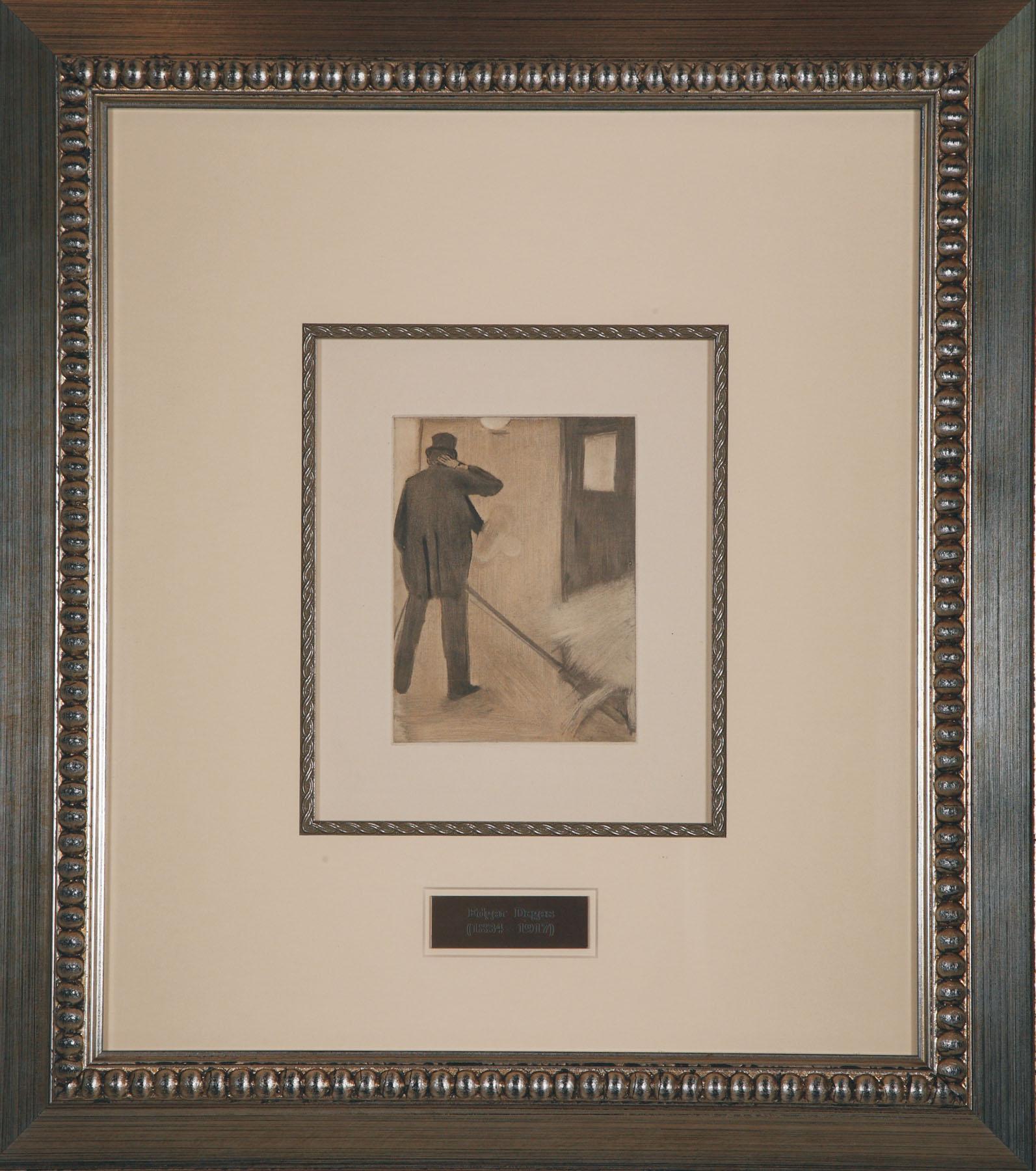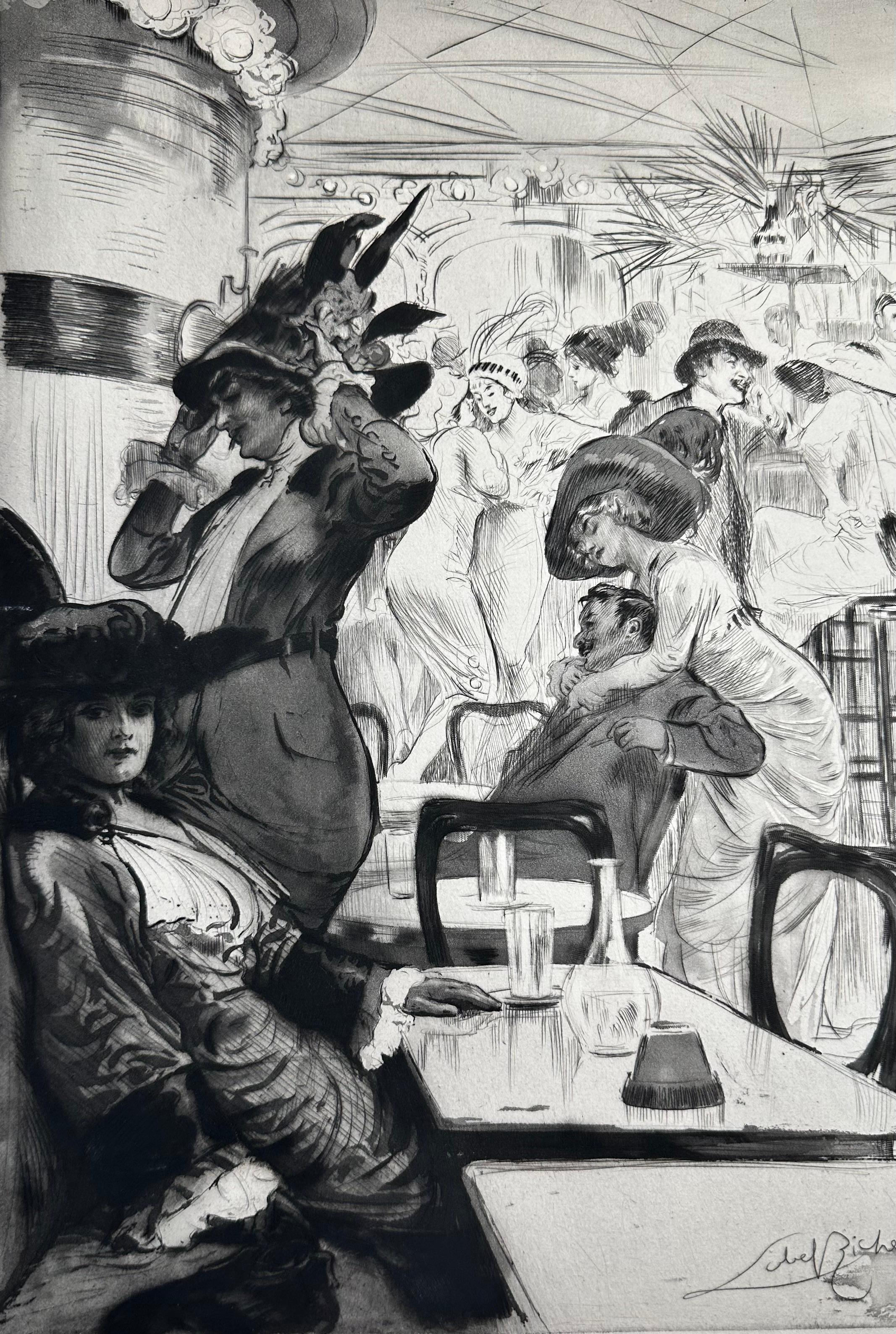Items Similar to Les Bars
Want more images or videos?
Request additional images or videos from the seller
1 of 5
Almery Lobel-RicheLes Bars1912
1912
About the Item
A very fine copy of "Les Bars," an album of ten original etchings by the master Lobel-Riche, representing fashionable women in various Parisian social settings. This album, part of a series, was commissioned according to his editor; to express "the sumptuous and picturesque lifestyle of the times in which the essentially French qualities of charm and elegance dominate". The result is an ensemble of ten charming scenes of pre-war Paris, in which the women's costumes and attitudes are rendered with lively precision. This copy is exceptionally rare as it is one of six collaborator's copies with colored etchings, as well as eleven smaller additional etchings; on vellum.
- Creator:Almery Lobel-Riche (1880-1950, French)
- Creation Year:1912
- Dimensions:Height: 15 in (38.1 cm)Width: 12 in (30.48 cm)
- Medium:
- Movement & Style:
- Period:
- Condition:
- Gallery Location:Wilton, CT
- Reference Number:1stDibs: LU1362213401842
About the Seller
4.8
Vetted Seller
These experienced sellers undergo a comprehensive evaluation by our team of in-house experts.
1stDibs seller since 2020
23 sales on 1stDibs
Typical response time: <1 hour
- ShippingRetrieving quote...Ships From: Wilton, CT
- Return PolicyThis item cannot be returned.
More From This SellerView All
- Les Bars, selected printsBy Almery Lobel-RicheLocated in Wilton, CT6 plates from the Lobel- Riche books, Les Bars depicting pre- war Paris fashions in the bars and nightclubs.Category
1910s Art Nouveau Figurative Prints
MaterialsEtching
- Adam and EvaLocated in Wilton, CTWith 15 (8 signed) coloured original etchings and aquatints by C. E. Uphoff. Original vellum with gilt cover vignette in private linen case with gilt title on spine (stained due to m...Category
1920s Art Nouveau Figurative Prints
MaterialsAquatint
- La Nuit Venitienne, Fantasio, Les Caprices de MarianneBy Umberto BrunelleschiLocated in Wilton, CTBrunellechi's classic color drawings elegantly illustrate three plays by Musset, "La Nuit Venitienne", "Fantasio", and "Les Caprices de Marianne"Category
1910s Figurative Prints
MaterialsPaper, Aquatint
- Conte des 1001 NuitsBy Kees van DongenLocated in Wilton, CTThe Tale of a Thousand and One Nights is interpreted by Dutch painter and illustrator Kees Van Dongen in over one hundred full-page original black and white line drawings and seven f...Category
1910s Art Deco Figurative Prints
MaterialsGouache
- Anatomie de Mon UniversBy André MassonLocated in Wilton, CTReprint of Andre Masson's book from 1939. Printed on heavy wove paper. 30 plates of black and white drawings.Category
1930s Surrealist Figurative Prints
MaterialsLithograph
- Les Robes de Paul PoiretBy Paul IribeLocated in Wilton, CTThe first of Poiret's two deluxe fashion albums featuring 10 full page (2 fold-out) pochoir illustrations by Paul Iribe. Poiret's syles indicate the new freedom in women's fashions ...Category
Early 1900s Art Deco Figurative Prints
MaterialsOther Medium
You May Also Like
- "Ludovic Halevy Backstage" from La Famille Cardinal after Edgar DegasBy (after) Edgar DegasLocated in Hinsdale, ILDegas, Edgar (after) (1834 -1917) "Ludovic Halevy Backstage" Monod 5797, Adhemar 71, Skira 58, Stern 25 Soft-Ground Etching created from a Monotype, 1938-9 First State. # 251 from ...Category
Early 20th Century Art Nouveau Figurative Prints
MaterialsEtching
- "Portrait of Madame Georges Menier" By HelleuBy Paul César HelleuLocated in Hinsdale, ILHELLEU, PAUL CÉSAR (1859 - 1927) MADAME GEORGES MENIER Montesquiou XXI Drypoint in colors, c. 1900 Signed in pencil, lower right Printed on wove paper Full Margins 22 1/4” x 13...Category
Early 19th Century Art Nouveau Figurative Prints
MaterialsDrypoint, Etching
- L'Aieule (The Grandmother)By Louis LegrandLocated in Fairlawn, OHL'Aieule (The Grandmother) Etching and aquatint printed in colors, 1904 Signed with the red stamp of the publisher, Gustave Pellet, Lugt 1193 and numbered (see photo) Edition: 100 (81/100) Reference: Arwas 202 iv/IV IFF 98 Condition: Excellent, the sheet aged as usual Image size: 14 1/4 x 18 5/8" Sheet size: 16 15/16 x 24 1/4" Louis Auguste Mathieu Legrand (29 September 1863 – 1951) was a French artist, known especially for his aquatint engravings, which were sometimes erotic. He was awarded the Légion d'honneur for his work in 1906. Life Legrand was born in the city of Dijon in the east of France. He worked as a bank clerk before deciding to study art part-time at Dijon's Ecole des Beaux-Arts. He won the Devosge prize at the school in 1883.[2] In 1884 Legrand studied engraving under the Belgian printmaker Félicien Rops. Legrand's artworks include etchings, graphic art and paintings. His paintings featured Parisian social life. Many were of prostitutes, dancers and bar scenes, which featured a sense of eroticism. According to the Hope Gallery, "Louis Legrand is simply one of France's finest early twentieth century masters of etching." His black and white etchings especially provide a sense of decadence; they have been compared to those of Henri de Toulouse-Lautrec, though his drawings of the Moulin Rouge, the can-can dance and the young women of Montmartre preceded Toulouse-Lautrec's paintings of similar scenes. He made over three hundred prints of the night life of Paris. They demonstrate "his remarkable powers of observation and are executed with great skill, delicacy, and an ironic sense of humor that pervades them all." Two of his satirical artworks caused him to be tried for obscenity. The first, "Prostitution" was a symbolic drawing which depicted a naked girl being grasped by a dark monster which had the face of an old woman and claws on its hands; the second, "Naturalism", showed the French novelist Émile Zola minutely studying the thighs of a woman with a magnifying glass. Defended by his friend the lawyer Eugène Rodrigues-Henriques (1853–1928), he was found not guilty in the lower court, but was convicted in the appeal court and then given a short prison sentence for refusing to pay his fine. Legrand was made famous by his colour illustrations for Gil Blas magazine's coverage of the can-can, with text by Rodrigues (who wrote under the pseudonym Erastene Ramiro). It was a tremendous success, with the exceptional quantity of 60,000 copies of the magazine being printed and instantly sold out in 1891. In 1892, at the instigation of the publishing house Dentu, Legrand made a set of etchings of his Gil Blas illustrations. The etchings were published in a book, Le Cours de Danse Fin de Siecle (The End of the Century Dance Classes). Legrand took a holiday in Brittany, which inspired him to engrave a set of fourteen lithographs of simple country life called Au Cap de la Chevre (On Goat Promontory). It was published by Gustave Pellet who became a close friend of Legrand's. Pellet eventually published a total of 300 etchings by Legrand, who was his first artist; he also published Toulouse-Lautrec and Félicien Rops among others. He did not only work in graphics; he exhibited paintings at the Paris salon of the Société Nationale des Beaux-Arts starting in 1902. In 1906 he was made a chevalier of the Légion d'honneur. Legrand died in obscurity in 1951. A retrospective exhibition was held at the Félicien Rops museum in Namur, Belgium in 2006 to celebrate his graphic art. The art collector Victor Arwas published a catalogue raisonné for the occasion. Books illustrated de Maupassant, Guy: Cinq Contes Parisiens, 1905. Poe, Edgar Alan: Quinze Histoires d'Edgar Poe...Category
Early 1900s Art Nouveau Figurative Prints
MaterialsAquatint
- Danseuses s'habillant (Laurence adjusting her hair and Mignon adjusting clothesBy Louis LegrandLocated in Fairlawn, OHDanseuses s'habillant (Laurence adjusting her hair and Mignon adjusting hre clothes) Drypoint & aquatint, 1893 Signed in the plate (see photo) After the division of the plate into A. 81 (as here) and A. 82 Divant la glace Editon 100 printed on velin paper Issued by Pellet in the set, Les Petites du Ballet, Gustave Pellet editeur, 1893 (13 plates), second state (b) without remarque Reference: Arwas 81, top portion of the plate vii/VIII Plate/Image size: 6 x 8 7/16 inches Condition: excellent Louis Auguste Mathieu Legrand (29 September 1863 – 1951) was a French artist, known especially for his aquatint engravings, which were sometimes erotic. He was awarded the Légion d'honneur for his work in 1906. Life Legrand was born in the city of Dijon in the east of France. He worked as a bank clerk before deciding to study art part-time at Dijon's Ecole des Beaux-Arts. He won the Devosge prize at the school in 1883.[2] In 1884 Legrand studied engraving under the Belgian printmaker Félicien Rops. Legrand's artworks include etchings, graphic art and paintings. His paintings featured Parisian social life. Many were of prostitutes, dancers and bar scenes, which featured a sense of eroticism. According to the Hope Gallery, "Louis Legrand is simply one of France's finest early twentieth century masters of etching." His black and white etchings especially provide a sense of decadence; they have been compared to those of Henri de Toulouse-Lautrec, though his drawings of the Moulin Rouge, the can-can dance and the young women of Montmartre preceded Toulouse-Lautrec's paintings of similar scenes. He made over three hundred prints of the night life of Paris. They demonstrate "his remarkable powers of observation and are executed with great skill, delicacy, and an ironic sense of humor that pervades them all." Two of his satirical artworks caused him to be tried for obscenity. The first, "Prostitution" was a symbolic drawing which depicted a naked girl being grasped by a dark monster which had the face of an old woman and claws on its hands; the second, "Naturalism", showed the French novelist Émile Zola minutely studying the thighs of a woman with a magnifying glass. Defended by his friend the lawyer Eugène Rodrigues-Henriques (1853–1928), he was found not guilty in the lower court, but was convicted in the appeal court and then given a short prison sentence for refusing to pay his fine. Legrand was made famous by his colour illustrations for Gil Blas magazine's coverage of the can-can, with text by Rodrigues (who wrote under the pseudonym Erastene Ramiro). It was a tremendous success, with the exceptional quantity of 60,000 copies of the magazine being printed and instantly sold out in 1891. In 1892, at the instigation of the publishing house Dentu, Legrand made a set of etchings of his Gil Blas illustrations. The etchings were published in a book, Le Cours de Danse Fin de Siecle (The End of the Century Dance Classes). Legrand took a holiday in Brittany, which inspired him to engrave a set of fourteen lithographs of simple country life called Au Cap de la Chevre...Category
1890s Art Nouveau Figurative Prints
MaterialsAquatint
- Heureux age! (Happy Age!)By Victor MignotLocated in Fairlawn, OHHeureux age! (Happy Age!) Etching and aquatint. c, 1900 Signed lower right in pencil Edition; 50 (14/50) Published by Edmund Sagot, Paris Sagot blindstamp, Lugt 2254, lower right Con...Category
Early 1900s Art Nouveau Figurative Prints
MaterialsAquatint
- Troubadour, from The Mastersingers of NurembergLocated in Middletown, NYStipple point etching on tissue-thin handmade Japon paper, 7 5/8 x 5 inches (193 x 126 mm), full margins. Signed, titled, dated, inscribed and numbered 10/25 in pencil, lower margin....Category
Early 20th Century Jugendstil Landscape Prints
MaterialsHandmade Paper, Etching
Recently Viewed
View AllMore Ways To Browse
Print Of The Jerusalem Window
Broadway Set Design
Will George Bird
Renoir Lithograph Signed
Royal Antiques New Orleans
Ceramic Erotic Art
Chagall Bible 1930
Charles A Platt
Ref Plates
Peter Max Liberty 2001
Print Red Robe
A Flame In My Heart
Pennsylvania House Recliner
Schiaparelli Perfume Bottle
Sewing Doll
Alice In Wonderland 1st Edition
Jose Guimaraes
Prints Churches




